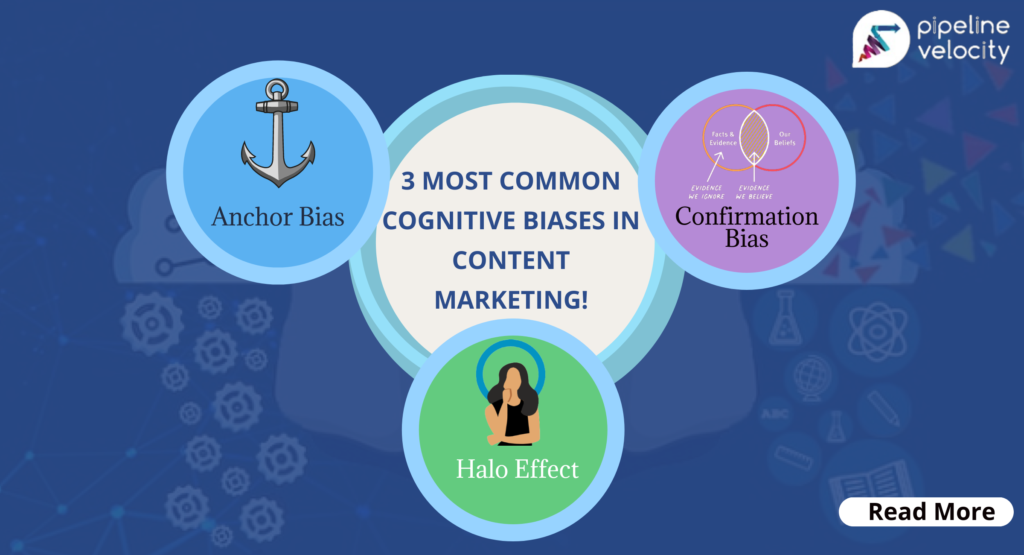Did you know the human brain processes about 100,000 words every day? While this might interest some people, it has a new meaning in content marketing.
Our brain is designed to skip information that seems irrelevant to us. This quality also boosts its ability to speed up the time required for processing the data it reads. Due to these behaviors of the human brain, cognitive biases appear in content marketing.
So in today’s article, we will discuss the three most common cognitive biases used in the content marketing industry. Therefore, let us jump into the details without wasting any more time!
3 Most Common Cognitive Biases in Content Marketing
The next time you create content for your audience, keep these three cognitive biases in mind to procure better results!
1. Anchoring Bias
Anchoring bias is a cognitive bias that occurs when people rely too heavily on the first piece of information they receive when making decisions. This bias can cause people to be overly influenced by the initial information they encounter, even if it is irrelevant or misleading.
In content marketing, anchoring bias can significantly impact how people perceive and respond to marketing messages. One way that anchoring bias can manifest in content marketing is through pricing information.
Anchoring bias can also affect how people interpret claims made in marketing messages. For example, suppose an article highlights the benefits of a particular product or service. In that case, people may be more likely to accept those claims as valid if they are presented at the beginning of the article.
To avoid anchoring bias in content marketing, it is essential to be mindful of how information is presented. This means avoiding tactics like misleading pricing information or selectively highlighting specific claims while downplaying.
Tips on Anchoring Bias
- Give an initial price – Always mention the original price of the products first and then reveal the discounts and offers. This way, readers are hooked to the first mentioned number and find your offers valuable.
- Make your selling proposition exceptional – Make your proposition straightforward. Mention what you offer, and describe the unique features and benefits.
- Add metrics – Graphs, statistics, and numbers will help you gain your readers’ trust.
- Include graphics – illustrations, and images to make your article more engaging.
2. Halo Effect
The Halo effect creates a positive impression of a brand or product by associating it with other positive associations or qualities. By linking a product or service to something already well-liked or respected, the positive perception of that thing can transfer onto the product creating a positive halo effect.
For example, a company sponsors a popular event or partners with a well-known influencer to promote their product. By associating its brand with the popularity and positive reputation of the event or influencer, the company can create a positive impression of its brand even if consumers have never heard of them before.
Another way companies use the halo effect in content marketing is by using social proof. By highlighting positive reviews or endorsements from satisfied customers or industry experts, the company can create a positive reception of its product or service as consumers assume that the positive qualities of the reviewer will extend to the product itself.
However, companies must be genuine in using the halo effect in content marketing. Consumers are increasingly savvy and can quickly recognize when an association feels forced or disingenuous. Companies must ensure that any association they use genuinely reflects their values and qualities, or they risk damaging the positive halo effect they are trying to create.
Tips on Halo Effect:
- Sell the experience instead of the product – Write your content as a story to help the reader understand the actual value of your products or services.
- Optimize your webpage – Ensure that your website works efficiently and looks appealing.
- Look for competitive advantage – Instead of just selling your services and products, consider solving customer issues.
3. Confirmation Bias
Confirmation bias refers to the tendency of individuals to seek out information that confirms their preexisting beliefs while disregarding or minimizing contradictory information.
In content marketing, this bias can be used strategically to create content that resonates with the audience and reinforces their beliefs or values.
Marketers often create content that aligns with the beliefs and values of their target audience. For example, if a company is environmentally conscious, it may create content highlighting its eco-friendly products and initiatives to appeal to consumers’ values.
Confirmation bias can also be used in the way content is presented. Marketers may selectively choose data, statistics, and examples that support their message while downplaying or ignoring contradictory evidence.
However, confirmation bias can also be a double-edged sword. If a consumer feels that a company is manipulating information to support their predetermined beliefs or values, it can undermine trust and credibility.
To mitigate the adverse effects of confirmation bias, marketers must present a balanced perspective and consider alternative viewpoints. This can help build trust with the audience and establish the company as a credible source of information.
Tips on Confirmation Bias
- Establish content with favorable presumptions – Making people believe in stereotypes is easier. Having a positive reputation for the business can help you market it better.
- Include testimonials from former clients – Readers are always searching for evidence to back the information provided by you. What better way than to include testimonials from your former clients?
Summing Up!
Cognitive biases can significantly affect content marketing strategies and hinder their success. The three most common biases discussed in this article were confirmation bias, availability bias, and bandwagon effect.
It is essential for content marketers to be aware of these biases and to take steps to mitigate their impact by doing thorough research, considering multiple perspectives, and avoiding relying solely on popular opinions.
We hope this article helped you understand the cognitive biases in content marketing. If you liked this article, visit our page for more informative content!







